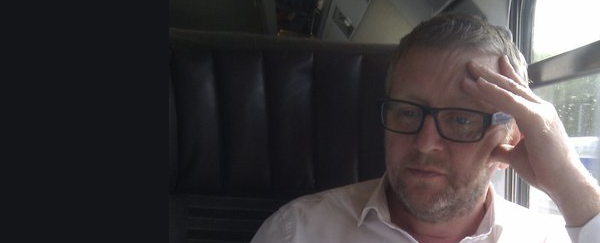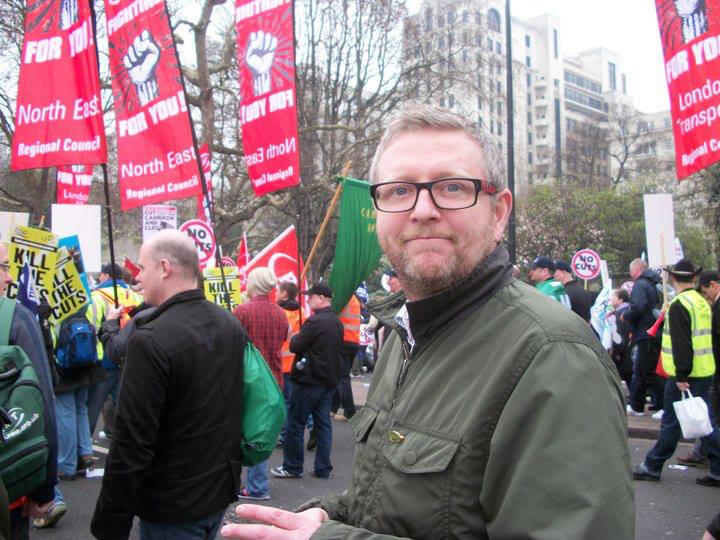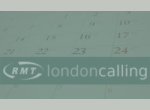Brian Munro wrote this article about his experiences of living with Ocular Melanoma Metastasis for OcumelUk, a charity helping and supporting patients with OM.
I was first diagnosed with Ocular Melanoma (OM) in December 2007. It was shocking news but the doctors at Moorfields told me they could treat it. I was told it could spread but they seemed confident that the prognosis was good. Following Proton Beam Therapy the lesion in my eye was shrinking, I had the usual liver ultra sounds and blood tests done on a regular basis showing that everything was fine. Despite the assurances from Moorfields I still found the diagnosis extremely difficult.
My work (I’m a train driver on London Underground) organised counselling for me which was very useful. It’s important, I think, to have that space to discuss your concerns and fears. But despite the assurances, despite the counselling, the cancer had a major impact on my life – it was the first thing that I would think of when I opened my eyes in the morning and was overwhelming throughout the day. The worry pretty much took over my life, it even affected my relationship – I live with my partner Lucy and two young daughters, Isobel and Brenna, and at one point it looked like we would break up. But after a full year following the treatment I realised I had to break out of the worry and depression and try to live my life as normally as possible: the lesion was shrinking, the scans and bloods were all good. Time to move on. And I did.
Then in July 2012 I had my annual liver ultra sound. The radiologist was very cagey. Normally they do the scan and say everything is fine. This time I was told she was going to look at my previous scans and let my doctor know the results - the GP will have the report in a week. I knew something was wrong.
I went to the online OM community to do some research and to try to find out the options. It didn’t look good. But I did find out some basic stuff – this is now a liver issue and this is the next course of action – treat the liver! I contacted my doctors surgery – my GP who has been my main point of contact on all matters OM was on holiday – and I was told there was some issues with the scan and the surgery had referred me back to Moorfields. Why Moorfields, they are an eye hospital! I immediately made an appointment to see my GP for when he returned from holiday.
In the meantime I went back online. I found out about a charity called OcumelUK. Everything I needed to know was there on their website. I also made contact and spoke to two very important people: Lesley Kirkpatrick and Kathryn Curtis. It was made clear to me that this is now a liver issue and I have to find specialists who understand this and understand the need for speed. The quicker I can get an MRI done and a plan of action agreed on how to treat the liver, the longer I will live. I went to see my GP armed with this information and the contact details for Mr Neil Pierce, liver surgeon at Southampton University Hospital. My GP had never made a referral outside the London Primary Care Trust before, but with some persuasion he found out how to do it and the referral was made.

Within days I had seen Mr Pierce. CT and MRI scans were done, and when initially it was hoped that a liver resection could be carried out to cut out the two lesions, the scans had also showed lots of cancerous spots on my liver. So resection was ruled out, but there were other possibilities – sirspheres were radiological beads are inserted into the liver to kill the cancer or chemosaturation, an entirely new treatment which I could be a candidate for. After some discussions with the brilliant Interventional Radiologist, Dr Brian Stedman, it was agreed that I would be one of the first patients in the UK to have chemosat, were the liver is isolated from the rest of your body and directed high doses of a chemo agent flood the liver. I was told the treatment was very risky, there are inherent risks because of the nature of the procedure and as Dr Stedman hadn’t done it before I might die during the treatment. It was a risk worth taking and I agreed to the procedure.
I convinced myself I was going to die during the process. In the few weeks running up to the date for the treatment I had made all the necessary arrangements and had something of a last supper: my friends and comrades came round for dinner, good food was made, fine wines were drunk and goodbyes were said to all. So it was a happy surprise when I actually came round following the operation in September last year. Sore from the 6 hour procedure and still groggy from the anaesthetic, Dr Stedman told me the procedure went well and everyone was delighted with how it went. I spent the night in intensive care and was put on a normal ward the following day. In the afternoon I was fit enough to go home! Day by day I got stronger, so much that by the seventh day I was fit enough for me and the girls to do the school run on our bikes.
The first scans following the treatment were good and it was agreed that I would have another chemosaturation in December. This happened and following that procedure I was told the lesions were shrinking and the spots were less bright. It was hoped that I would have another procedure but a PT scan in February showed “something suspicious” in my upper arms, probably early bone metastasis and the decision was taken to put me on a course of ipilimumab. I’m undergoing that now and I seem to be reacting to the drug. Following the 3rd treatment I had crushing headaches and terrible lethargy, but we’ve found out that the Ipi had caused an inflamed pituitary gland and the drugs I’m taking for that immediately cleared the problem and I’m back to my normal self.
So obviously I’m hoping the Ipi will be beneficial. In the meantime though I’m looking at other options to keep fighting the cancer, for example, a new treatment is available at Christie’s Hospital in Manchester. Adoptive Lymphocite Transfer is another immune based treatment were the so-called killer T cells can be taken from a patient's own tumour, and grown in a laboratory to form a colony of millions - an attacking army of killer T-cells can then be safely re-injected into the patient. This potential treatment isn’t available at the moment on the NHS so I’m in the process of trying to raise money to be able to pay for this treatment privately. The response to this from friends, family, workmates and comrades in my trade union the RMT has been both astounding and humbling in equal measure. It is their solidarity that keeps me strong.

Brian on a demonstration with the RMT
Over the last year I’ve been lucky - I made the right contacts at the right time. Kathryn from OcumelUK has been an amazing source of knowledge, inspiration and courage. Part of the problem of course, is that with OM being such a rare cancer the research and resources into finding a cure or treatments that can prolong life are minimal compared with other cancers. So landing on the doorsteps at Southampton Hospital just at the right time when they were lining up the first chemosat treatments was obviously fantastic serendipity. And I can’t praise enough everyone at Southampton Hospital for their commitment to do their utmost to treat this cancer. Mr Pierce, Brian Stedman, Emma Ramsay and my oncologist – Dr Mathew Wheater are a team second to none dedicated to improving the options and treatments to keep patients with OM mets alive. But much more needs to be done to improve the understanding of OM across the length and breadth of the UK as a whole and the resources and funding in the NHS needs to be massively increased. Treatment’s for patients with OM mets should not be left to chance, serendipity or private funding!
I used the phrase earlier “fighting the cancer”. But I don’t actually believe that this is possible. There are lots of views and literature on this: ‘have a positive attitude’, ‘it’s important you fight the cancer’. You don’t have to fight heart disease or tuberculosis. You get treatment for these things: a new valve for the heart, antibiotics for the TB. My view is what you need to do for cancer is fight to get the best treatment available. Find out who the specialists are and fight to see them. The alternative option is to close the curtains and sit in the dark and wait to die. I love life. I love my family and friends, and I love my two wee girls – I want to be part of their lives for as long as I possibly can. I am not going to shut the curtains. I’ll take every day as it comes and do my best to live life to the full. Carpe Diem!
- Read about the Brian Munro Cancer Fighting Fund here.
- 7789 reads



